West Moors | |
|---|---|
| General information | |
| Location | West Moors, East Dorset, Dorset England |
| Coordinates | 50°49′35″N1°53′16″W / 50.82648°N 1.88779°W |
| Grid reference | SU080030 |
| Platforms | 2 |
| Other information | |
| Status | Disused |
| History | |
| Pre-grouping | London and South Western Railway |
| Post-grouping | Southern Railway Southern Region of British Railways |
| Key dates | |
| 1 August 1867 | Opened |
| 4 May 1964 | Closed to passengers |
| 1974 | Closed completely |
West Moors was a railway station in Dorset. Opened in 1867, it became the junction of the Southampton and Dorchester Railway and the Salisbury and Dorset Junction Railway. Although passenger services were withdrawn in 1964 as a result of the Beeching Report, the line remained open until 1974 for freight trains serving the Royal Army Ordnance Corps fuel depot at West Moors. The track was lifted in 1974.
| Preceding station | Disused railways | Following station | ||
|---|---|---|---|---|
| Verwood Line and station closed | British Rail Southern Region Salisbury and Dorset Junction Railway | Wimborne Line and station closed | ||
| Ashley Heath Line and station closed | British Rail Southern Region Southampton and Dorchester Railway |

The Somerset and Dorset Joint Railway, also known as the S&D, SDJR or S&DJR, was an English railway line connecting Bath and Bournemouth, with a branch from Evercreech Junction to Burnham-on-Sea and Bridgwater. Strictly speaking, the main line ran from Bath Junction to Broadstone, as the line between Broadstone and Bournemouth was owned by the London and South Western Railway, while the line between Bath Junction and Bath was owned by the Midland Railway.

Hamworthy railway station serves Hamworthy, an area of Poole in Dorset, England. It is 115 miles 77 chains (186.6 km) down the line from London Waterloo.

Ringwood is a closed railway station in the county of Hampshire, England which served the town of Ringwood. It lay on the former Southampton and Dorchester Railway, the original main line from a connection with the London and South Western Railway at Southampton through Brockenhurst to Dorchester.

Clifton Moor railway station was situated in England on the Eden Valley Railway between Penrith and Kirkby Stephen East. It served the village of Clifton. The station opened to passenger traffic on 1 August 1863, and was originally named 'Clifton'. The 'Moor' suffix was added on 1 September 1927. The station finally closed on 22 January 1962.

Brettell Lane railway station was a station on the Oxford-Worcester-Wolverhampton Line which served the town of Brierley Hill in England.

Breamore railway station was a railway station in the Avon Valley at the village of Breamore, Hampshire, England. The station was built for the Salisbury and Dorset Junction Railway and opened in 1866. It was served by trains between Salisbury in Wiltshire and West Moors in Hampshire. British Railways closed the station and the line on 2 May 1964.

Verwood railway station served the town of Verwood, Dorset, England from 1866 to 1964.
The Salisbury and Dorset Junction Railway was a railway company, that built a line from a junction near Salisbury to another near West Moors on the Ringwood to Wimborne line. It ran through the counties of Wiltshire, Hampshire and Dorset in England. It opened the line in 1866, and was worked by the London and South Western Railway (LSWR).

The Southampton and Dorchester Railway was an English railway company formed to join Southampton in Hampshire with Dorchester in Dorset, with hopes of forming part of a route from London to Exeter. It received parliamentary authority in 1845 and opened in 1847.
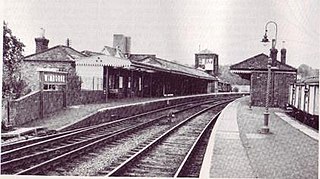
Wimborne was a railway station in Wimborne Minster in the county of Dorset in England. Open from 1 June 1847 to 2 May 1977, it was sited just north of the River Stour in what is still Station Road. Built for the Southampton and Dorchester Railway, the station was operated from the start by the London and South Western Railway, which took over ownership in 1848. It was then operated by the Southern Railway (1923–47) and from 1948 by the Southern Region of British Railways which traded as British Rail from 1965.
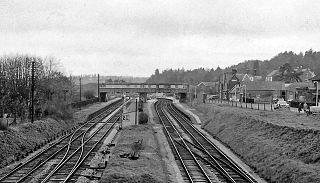
Broadstone was a railway station in the northern part of the Borough of Poole in the county of Dorset in England. It opened in 1872 under the name of New Poole Junction and closed to passengers in 1966. Between these dates there were several changes of name for a station which at its height provided a suburb of Poole with four substantial platforms and a goods yard. A prominent feature of the station was the large footbridge needed to span the four running lines.

Workington Central railway station was opened by the Cleator and Workington Junction Railway (C&WJR) in 1879 to serve the town of Workington in Cumberland, England. It was situated almost half a mile nearer the town centre than its rival Workington station.

Moor Row railway station was built by the Whitehaven, Cleator and Egremont Railway. It served the village of Moor Row, Cumbria, England.
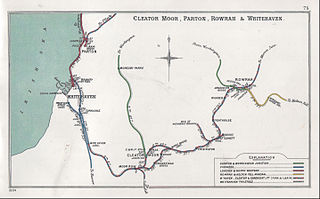
Cleator Moor has had three passenger stations:

Cleator Moor West railway station was opened as "Cleator Moor" by the Cleator and Workington Junction Railway (C&WJR) in 1879. It served the growing industrial town of Cleator Moor, Cumbria, England.

High Harrington railway station was opened by the Cleator and Workington Junction Railway (C&WJR) in 1879. It was situated half a mile south of Harrington Junction on the company's main line. and served what was then the eastern extremity of Harrington in Cumbria, England. The station is not to be confused with the current Harrington station a kilometre away on the coastal line.
Moresby Junction Halt railway station was opened by the Cleator and Workington Junction Railway (C&WJR) in 1910. Very few people lived near the halt, which served nearby Walkmill Colliery and coke ovens in Cumbria, England.

Moresby Parks railway station was opened by the Cleator and Workington Junction Railway (C&WJR) in 1879. It was situated just north of the summit of the company's main line and served the scattered community of Moresby Parks in Cumbria, England.
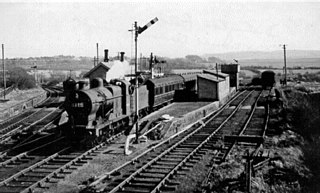
Distington railway station was opened jointly by the Cleator and Workington Junction Railway (C&WJR) and the LNWR and Furness Joint Railway on 1 October 1879. It was situated on the northern edge of the village of Distington, Cumbria, England, where the C&WJR's north–south main line crossed the Joint Line's east–west Gilgarran Branch.
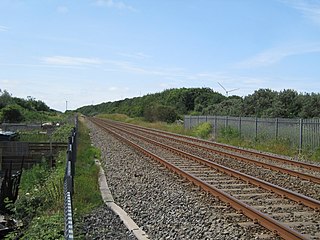
Siddick Junction railway station was opened by the Cleator and Workington Junction (C&WJR) and London and North Western Railways in 1880 to provide exchange platforms for passengers wishing to change trains from one company's line to the other. A passenger travelling from Maryport to Distington, for example, would change at Siddick Junction. As a purely exchange station - like Dovey Junction and Dukeries Junction elsewhere in the country - the owning companies would not need to provide road or footpath access or ticketing facilities as no passengers were invited to enter or leave the station except by train.